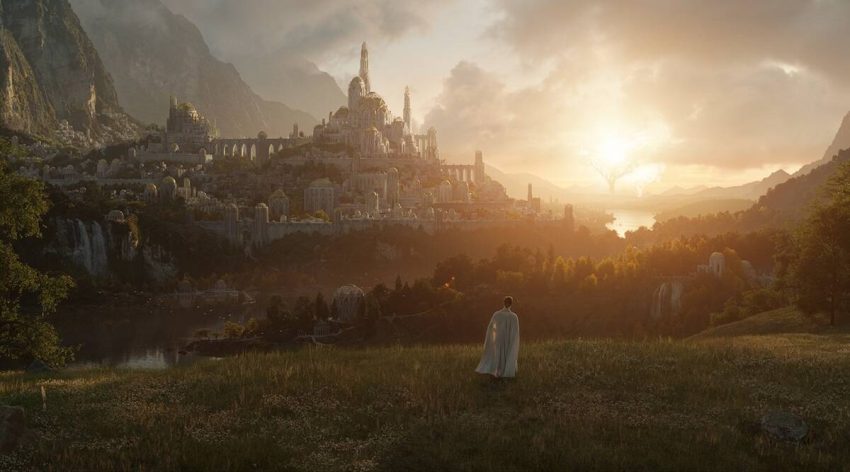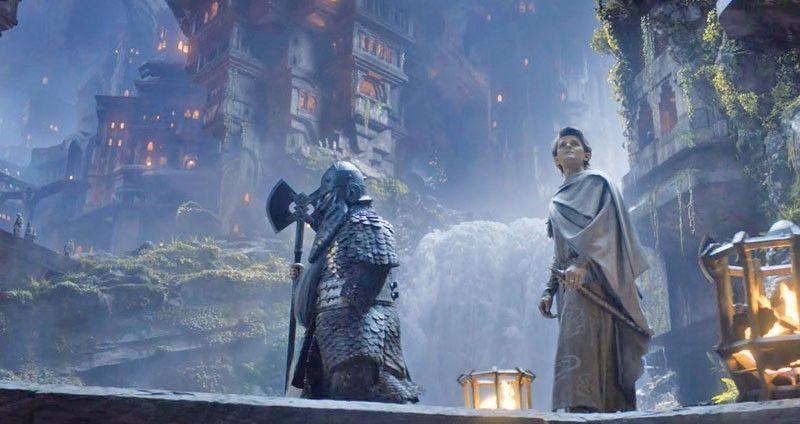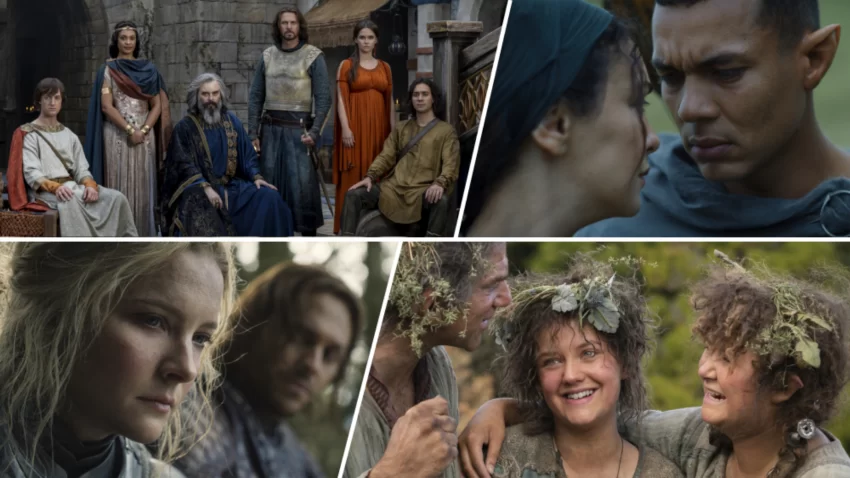Why Zelda Fans Will Enjoy The Grand Sights and Sounds of Lord of the Rings: The Rings of Power
Posted on November 11 2023 by Sean Gadus
Legendary Pictures is a series that focuses on tales from across film and television history that share the same DNA as The Legend of Zelda, where we discuss the content’s strengths and identify similarities to the various games in the Zelda series.
Warning: This article contains minor spoilers for The Lord of the Rings: The Rings of Power.
My love of The Legend of Zelda and The Lord of the Rings has some intriguing connections. I discovered both series in the early 2000s; I started playing Ocarina of Time around the same time my family bought a VHS tape of The Fellowship of the Ring. I also took a significant break from both series during different points of my life: the mid-2000s for Zelda and the mid-2010s for Lord of the Rings. However, over the past ten years, I have renewed and deepened my love for both series. Overall, I appreciate Hyrule and Middle Earth more than I ever have before.
My renewed interest in J.R.R. Tolkien’s Middle Earth was stoked by two key experiences: teaching The Hobbit and The Lord of the Rings, and the announcement of a new streaming series set during Middle Earth’s Second Age. Produced by Amazon, The Lord of the Rings: The Rings of Power has been the subject of some of the most hyperbolic discourse across the internet, with talking points ranging from worry over Amazon’s ownership of the property, the enormous size of the budget for the show, the casting of a diverse set of actors in the show, and the changes made to Tolkien’s extensive lore. Despite all of the roadblocks the show and its cast and crew faced, the show itself is an impressive achievement despite some obvious flaws.
Filled with gorgeous scenery created through the lush natural beauty of New Zealand and excellent computer-generated effects, Amazon Studios’ Rings of Power is one of the largest and most ambitious shows ever produced. Anchored by an incredible soundtrack, thrilling battles, and fun characters, Rings of Power is an overwhelming showcase of talent. For anyone who loves fantasy epics, Rings of Power is something precious to behold. With the announcement of the development of a live-action Zelda film, it makes sense for Zelda fans to seek out different fantasy films and shows so that fans can analyze how these properties develop their worlds and present their characters. Rings of Power brings the rich world of Middle Earth to life, and it provides a potential blueprint for other fantasy properties to make the jump to streaming or movie theaters. Additionally, Zelda fans looking for a grand adventure in a post-Tears of the Kingdom malaise could enjoy exploring the Second Age of Middle Earth.
Returning To One Of The Richest Fantasy Worlds Ever Crafted While We Wait For The Next Zelda Project

Fans of the Zelda series are no strangers to rich fantasy worlds. With the releases of Breath of the Wild and Tears of the Kingdom, Nintendo delivered a duology with an immense sense of scale. These open-world Zelda games have been embraced with overwhelming enthusiasm by many new and returning fans. While worlds like Hyrule and Westeros are richly developed and beloved, the scope, size, and rich lore of Middle Earth stands alone at the fantasy mountaintop. Tolkien’s legendarium has been a massive influence on fantasy worlds since the release of The Lord of the Rings in the 1950s. It is impossible to chart the development of the fantasy genre without discussing Tolkien and his creations.
Rings of Power takes place during the Second Age of Middle Earth, thousands of years before the events of The Hobbit and The Lord of the Rings trilogies. In many ways, the Second Age is a great time period for a series because it does not intrude on the events of the films and books already produced, nor is it as wild and unfilmable as Tolkien’s First Age content. The show is the first time that viewers get to see several key locations that are crucial to Middle Earth’s history and the lore behind The Lord of the Rings. In addition to the Elf Kingdoms of Lindon and Eregion, fans get to see the Dwarven kingdom of Khazad-dûm in its full glory (known as Moria in the Third Age). These places are grand on a scale that is rarely seen in fantasy television or film. The show also explores a tribe of Halflings known as the Harfoots, a tribe of Hobbits that migrate across Middle Earth. Most significantly, Rings of Power gives fans the real film representation of Númenor, the island nation destined to help shape the Third Age of Middle Earth.
Zelda fans will enjoy the diverse architecture and richly developed cultures of Middle Earth. Just like the Gorons, Zoras, Gerudo, and Hylians, the Dwarves, Elves, Humans, and Harfoots of Middle Earth have different values and belief systems. Watching these systems and ideas come into conflict, become subverted, or be melded together is part of what makes watching the show engaging. Even if you have never read or watched anything about Middle Earth or The Lord of the Rings, the show does a solid job of grounding the viewer in the different races and their cultures, along with helping the viewer understand what is important to them. One argument against the show is that it has too many characters and storylines to follow. Giving the massive cast of characters each their own satisfying arc is something that the show (and a significant amount of other big budget series) struggles with. One advantage of having a large cast of characters and a variety of settings is that the specific characters or locations never feel overused, and there is something for everyone to love. Since Rings of Power moves through the different storylines fluidly, fans always see their favorite characters in each episode.
The Natural Beauty of New Zealand Will Remind Viewers of Hyrule

Like Hyrule, Middle Earth is one of the most iconic and well-known fantasy settings ever created. In order to craft the visual backdrop for Rings of Power, the production team traveled to the two islands of New Zealand (the home of Peter Jackson’s Middle Earth trilogies) to film parts of Rings of Power. It is estimated that around thirty-five percent of the first season was filmed in the rich natural wonderland of New Zealand. The magnificent natural beauty of New Zealand is probably as close as a person can come to stepping into a fantasy world like Hyrule or Middle Earth. As the Zelda film project continues to develop, it will be intriguing to see what areas of the world (if any) that the filmmaker use as stand-ins for different locations in Hyrule. If you are interested in the real locations that the cast and crew of Rings of Power filmed in, I suggest you check out this article with more information about the New Zealand locations seen in the first season of the show.
Middle Earth is an incredibly diverse natural place that mirrors many of the grand sights that players can visit in Zelda games. Filled with towering mountain ranges, lush forests, beautiful fields, dank caverns, and sandy beaches, the grand world in Rings of Power inspires a sense of awe and wonder within the viewer. The first season of Rings of Power revels in taking fans to a variety of different regions throughout Middle Earth, and it is easy to see similarities between Middle Earth and Hyrule. The bustling island nation of Númenor shares some similarities with the bustling Hyrule Castle Town seen in Twilight Princess. The fields and low, rugged hills of the Southlands brings to mind a darker version of the Ordon Region shown in the early hours of Twilight Princess.
Overall, my time in Middle Earth has almost always pushed me back into Hyrule and vice versa. The two worlds are such magnificent creations that whenever I take a journey through the awe-inspiring vistas of one world, I am filled with the desire to return to the other world. My time with the awe-inspiring kingdoms of Númenor, Lindon, and Khazad-dûm in Rings of Power made me want to to pick up my Nintendo Switch and trek across the beautiful landscapes of Hebra, Necluda, and Akkala showcased in Breath of the Wild and Tears of the Kingdom.
A Magnificent Score That Captures The Spirit of An Amazing World

Composer Bear McCreary provides a diverse and grand score for Rings of Power that will delight Zelda fans. Overall, the soundtrack is the area where the show shines the brightest. The score captures the epic scope of Middle Earth without retreading or being too close to the immense soundtracks that Howard Shore created for Peter Jackson’s The Lord of the Rings trilogy (Howard Shore did return to write the title theme for Rings of Power). Due to the nature of Amazon’s rights agreement, McCreary was not able to reuse any work from the previous soundtracks, which cleared a path for the composer to develop a new musical language for Middle Earth. McCreary, who also showed off his impressive talents with the soundtracks for the new God of War games, creates a rich and diverse soundscape for this version of Middle Earth.
Like Koji Kondo’s music in Ocarina of Time, Bear McCreary’s music in Rings of Power does a lot of the heavy lifting in developing the different cultures seen within the world of Rings of Power. Lush strings, thunderous percussion, and beautiful choral arrangements are all key parts of the score, and the music plays a key role in helping the viewer identify where in Middle Earth a scene takes place. The music of the Harfoots is rooted in rustic music that instantly grounds the player in the rough, migrant life of the Halflings. The music of the Dwarves often includes booming choral arrangements that enhances the grandeur of their mountain halls. In contrast, the music accompanying the Orcs is defined by harsh, warlike chants and heavy percussion.
Much like Howard Shore’s score in The Lord of the Rings, the soundtrack of Rings of Power enhances key moments in the story. Some of these songs feel like stirring tributes to the riddles, poems, and songs littered across Tolkien’s various works. In one key sequence, a choir sing “A Plea to the Rocks,” a stirring prayer for a group of miners trapped deep in a collapsed mountain tunnel. With a powerful chorus, the song feels like it captures the essence of the Dwarves in the Second Age: pride, power, and a strong connection to the land they live in. “Wandering Day” is a moving song that plays over a striking montage of the Harfoots making a laborious journey across the rugged landscapes of Middle Earth. The song beautifully reflects on the tough migratory lives of the Harfoots while also highlighting the joy and perseverance that is the foundation of their people. Additionally, the finale of Season 1 includes a secret treat for long time Tolkien fans, a song that is sure to send shivers down the spines of many fans.
A Diverse Set of Characters To Anchor A Grand Fantasy Adventure

While the show has a rich set of characters, the elven warrior Galadriel takes center stage in Rings of Power. This version of Galadriel is rash, fierce, and relentless, quite different from the wise and mournful Galadriel viewers see in the Lord of the Rings trilogy. While Galadriel’s portrayal on Rings of Power may not match up with her role in Tolkien’s canon (another major criticism of the show), the character seen in Rings of Power is a fascinating one. Much like Link and Zelda in Breath of the Wild and Tears of the Kingdom, Galadriel has dealt with immense trauma that has reshaped her outlook on life. Galadriel is scarred by the violence and horrors that she witnesses in the First Age, which on a macro scale included a war against the Dark Lord Morgoth, and on an intimate level, Galadriel dealt with the tragic death of her brother Finrod. These losses, along with her belief that evil is lurking somewhere in Middle Earth, puts Galadriel at odds with many of the other Elves who wish to put down their weapons. Galadriel’s restlessness and desire for vengeance are ineteresting character traits that put her at odds with many characters in the show.
Much like the characters of the Zelda series, many of the characters and races in Rings of Power feel like grand archetypes. The Dwarves are proud craftspeople and distrustful of outsiders meddling in their affairs, but they are also full of joy and have sharp senses of humor. The Elves of Middle Earth are powerful and wise, and they view themselves distinct from the other races of Middle Earth. This wisdom (or arrogance) earns the Elves a healthy amount of resentment and distrust from the other races of Middle Earth. The Harfoots (the predecessors to the Hobbits), live rich and dangerous lives as nomads, relying on the strength of their community to survive the perils of Middle Earth. It is easy to identify a few key attributes that define the different groups, but the show also plays with expectations by having characters break these restrictive archetypes. The friendship of the Dwarf Durin and Half-Elf Elrond is one of the highlights of series, illustrating how friendship and comradery can transcend tribalism.
Conclusion — A Fantasy Show To Feed Your Appetite

If you have Amazon Prime Video, The Lord of the Rings: The Rings of Power is a great show for fantasy fans and Zelda fans to dig into.
If you are looking for a sprawling fantasy epic to tide you over while you wait for the next Zelda project, then Rings of Power should be your next viewing experience. The beautiful cinematography, inspiring music, diverse cast, and iconic locations make the show feel distinct from anything else on streaming! Every episode reveals more wonders as the viewer dive deep into the Second Age of Middle Earth. While the Zelda movie could potentially be years away, I will be thrilled if it is able to capture the glory and beauty of Hyrule in the same way that Rings of Power captures the glory and beauty of Middle Earth.

Sean Gadus is a Senior Editor at Zelda Dungeon. His first Zelda game was Ocarina of Time, and he loves all of the 3D Zelda games from 1998-2011. The final battle of Tears of the Kingdom is one of his favorite final battles in the entire series. He wants to help build a kinder, more compassionate world. You can check out his other written work at The-Artifice.com.



